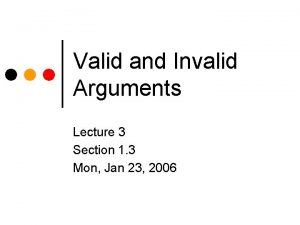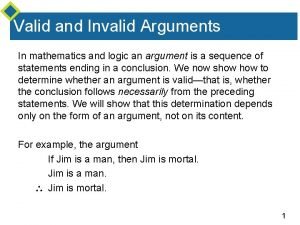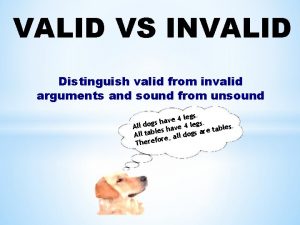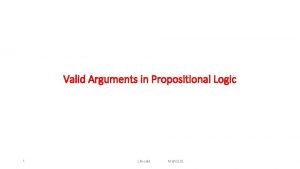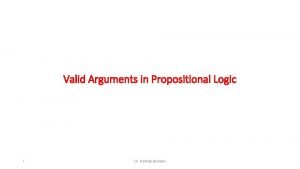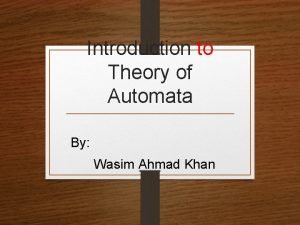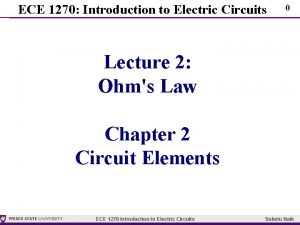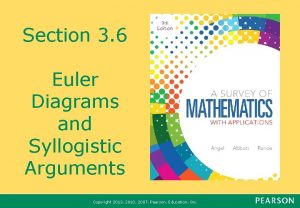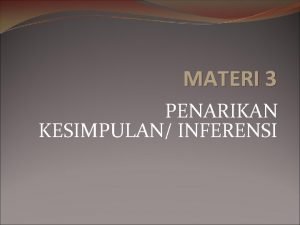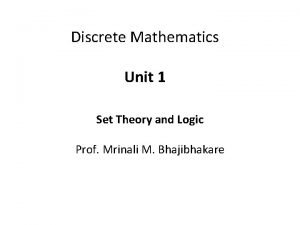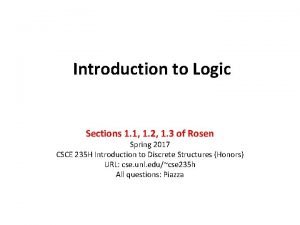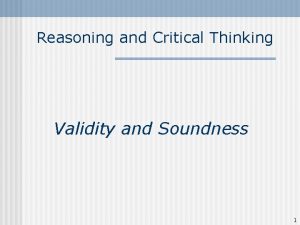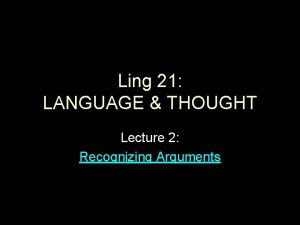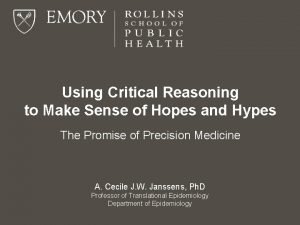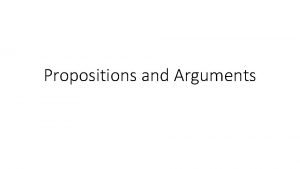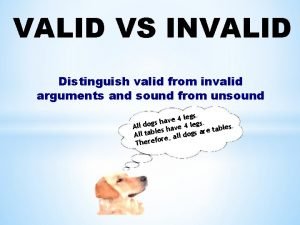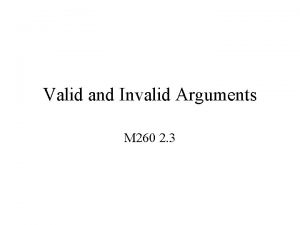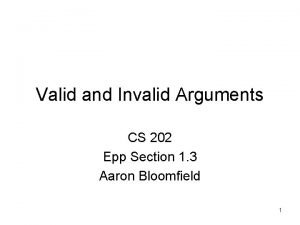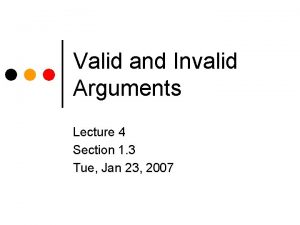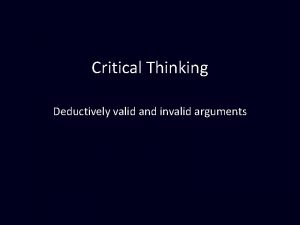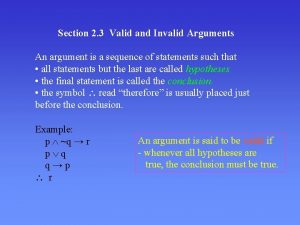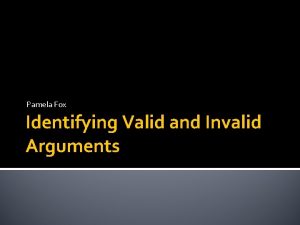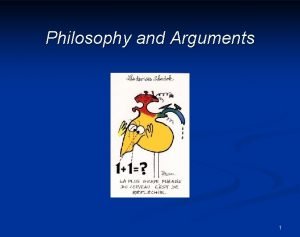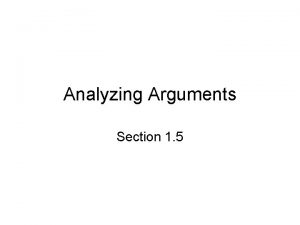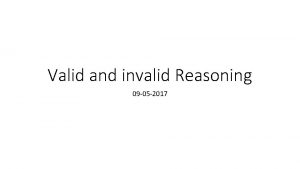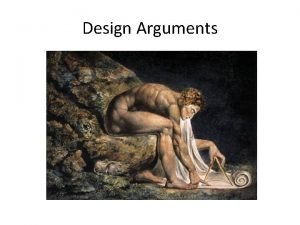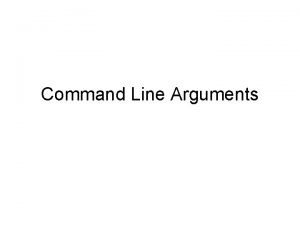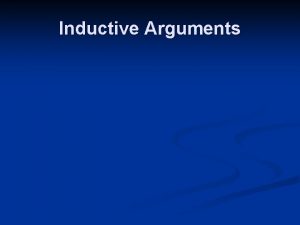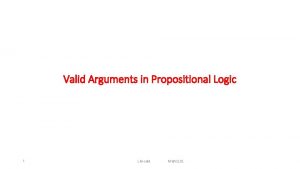Valid and Invalid Arguments In mathematics and logic
































- Slides: 32

Valid and Invalid Arguments In mathematics and logic an argument is a sequence of statements ending in a conclusion. We now show to determine whether an argument is valid—that is, whether the conclusion follows necessarily from the preceding statements. We will show that this determination depends only on the form of an argument, not on its content. For example, the argument If Jim is a man, then Jim is mortal. Jim is a man. Jim is mortal. 1

Valid and Invalid Arguments has the abstract form If p then q p q When considering the abstract form of an argument, think of p and q as variables for which statements may be substituted. An argument form is called valid if, and only if, whenever statements are substituted that make all the premises true, the conclusion is also true. 2

Valid and Invalid Arguments An argument (form) is a sequence of statements (statement forms). All statements (statement forms) but the last are called premises, hypotheses, or assumptions. The last statement (form) is called the conclusion. The conclusion is preceded by “ ” (said “therefore”). An argument (form) is valid if whenever its premises are true, then its conclusion is also true. 3

Valid and Invalid Arguments Testing an Argument Form for Validity 1. Identify the premises and conclusion of the argument form. 2. Construct a truth table showing the truth values of all the premises and the conclusion. 3. A row of the truth table in which all the premises are true is called a critical row. If there is a critical row in which the conclusion is false, then it is possible for an argument of the given form to have true premises and a false conclusion, and so the argument form is invalid. If the conclusion in every critical row is true, then the argument form is valid. 4

Example 1 – Determining Validity or Invalidity Is this a valid argument form? p → q ∨ ∼r q → p ∧ r p → r 5

Example 1 – Solution cont’d Solution: The truth table shows that even though there are several situations in which the premises and the conclusion are all true (rows 1, 7, and 8), there is one situation (row 4) where the premises are true and the conclusion is false. 6

Modus Ponens and Modus Tollens The most argument form in logic is called modus ponens. It has the following form: If p then q. p q 7

Modus Ponens and Modus Tollens It is instructive to prove that modus ponens is a valid form of argument, if for no other reason than to confirm the agreement between the formal definition of validity and the intuitive concept. To do so, we construct a truth table for the premises and conclusion. 9

Modus Ponens and Modus Tollens The first row is the only one in which both premises are true, and the conclusion in that row is also true. Hence the argument form is valid. Now consider another valid argument form called modus tollens. It has the following form: If p then q. ∼q ∼p 10

Additional Valid Argument Forms: Rules of Inference A rule of inference is a form of argument that is valid. Thus modus ponens and modus tollens are both rules of inference. The following are additional examples of rules of inference that are frequently used in deductive reasoning. 13

Example 3 – Generalization The following argument forms are valid: a. p b. q p ∨ q p ∨ q These argument forms are used for making generalizations. For instance, according to the first, if p is true, then, more generally, “p or q” is true for any other statement q. As an example, suppose you are given the job of counting the upperclassmen at your school. You ask what class Anton is in and are told he is a junior. 14

Example 3 – Generalization cont’d You reason as follows: Anton is a junior. (more generally) Anton is a junior or Anton is a senior. Knowing that upperclassman means junior or senior, you add Anton to your list. 15

Example 4 – Specialization The following argument forms are valid: a. p ∧ q b. p ∧ q p q These argument forms are used for specializing. When classifying objects according to some property, you often know much more about them than whether they do or do not have that property. When this happens, you discard extraneous information as you concentrate on the particular property of interest. 16

Example 4 – Specialization cont’d For instance, suppose you are looking for a person who knows graph algorithms to work with you on a project. You discover that Ana knows both numerical analysis and graph algorithms. You reason as follows: Ana knows numerical analysis and Ana knows graph algorithms. (in particular) Ana knows graph algorithms. Accordingly, you invite her to work with you on your project. 17

Example 5 – Elimination The following argument forms are valid: a. p ∨ q b. p ∨ q ∼q ∼p q These argument forms say that when you have only two possibilities and you can rule one out, the other must be the case. 18

Example 6 – Transitivity The following argument form is valid: p→q q→r p → r Many arguments in mathematics contain chains of if-then statements. From the fact that one statement implies a second and the second implies a third, you can conclude that the first statement implies the third. 20

Example 7 – Proof by Division into Cases The following argument form is valid: p ∨ q p → r q → r r It often happens that you know one thing or another is true. If you can show that in either case a certain conclusion follows, then this conclusion must also be true. 22

Example 7 – Proof by Division into Cases cont’d For instance, suppose you know that x is a particular nonzero real number. The trichotomy property of the real numbers says that any number is positive, negative, or zero. Thus (by elimination) you know that x is positive or x is negative. You can deduce that x 2 > 0 by arguing as follows: x is positive or x is negative. If x is positive, then x 2 > 0. If x is negative, then x 2 > 0. 23

Example 8 – Application: A More Complex Deduction You are about to leave for school in the morning and discover that you don’t have your glasses. You know the following statements are true: a. If I was reading the newspaper in the kitchen, then my glasses are on the kitchen table. b. If my glasses are on the kitchen table, then I saw them at breakfast. c. I did not see my glasses at breakfast. d. I was reading the newspaper in the living room or I was reading the newspaper in the kitchen. e. If I was reading the newspaper in the living room then my glasses are on the coffee table. Where are the glasses? 24

Fallacies A fallacy is an error in reasoning that results in an invalid argument. Three common fallacies are … • using ambiguous premises, and treating them as if they were unambiguous, • circular reasoning (assuming what is to be proved without having derived it from the premises), and • jumping to a conclusion (without adequate grounds). Two other fallacies • converse error and • inverse error which give rise to arguments that superficially resemble those that are valid by modus ponens and modus tollens but are not, in fact, valid. 28

Example 9 – Converse Error Show that the following argument is invalid: If Jim is a cheater, then Jim sits in the back row. Jim is a cheater. Solution: The first premise gives information about Jim if it is known he is a cheater. It doesn’t give any information about him if it is not already known that he is a cheater. 29

Example 9 – Solution cont’d The general form of the previous invalid argument is as follows: p→q q p The fallacy underlying this invalid argument form is called the converse error because the conclusion of the argument would follow from the premises if the premise p → q were replaced by its converse. 30

Example 10 – Inverse Error Consider the following invalid argument: If Jim is a cheater, then Jim sits in the back row. Jim is not a cheater. Jim does not sit in the back row. Note that this invalid argument has the following form: p→q ∼p ∼q The fallacy underlying this invalid argument form is called the inverse error because the conclusion of the argument would follow from the premises if the premise p → q were replaced by its inverse. 31

Example 10 – Inverse Error cont’d The fallacy underlying this invalid argument form is called the inverse error because the conclusion of the argument would follow from the premises if the premise p → q were replaced by its inverse. 32

Soundness 33

Example 11 – A Valid Argument with a False Premise and a False Conclusion The argument below is valid by modus ponens. But the first premise is false, and so is its conclusion. If John Lennon was a rock star, then John Lennon had red hair. John Lennon was a rock star. John Lennon had red hair. 34

Example 12 – An Invalid Argument with True Premises and a True Conclusion The argument below is invalid by the converse error, but it has a true conclusion. If New York is a big city, then New York has tall buildings. New York has tall buildings. New York is a big city. 35

Contradictions and Valid Arguments The concept of logical contradiction can be used to make inferences through a technique of reasoning called the contradiction rule. Suppose p is some statement whose truth you wish to deduce. 36

Example 13 – Contradiction Rule Show that the following argument form is valid: ∼p → c, where c is a contradiction p Solution: Construct a truth table for the premise and the conclusion of this argument. 37

Contradictions and Valid Arguments The contradiction rule is the logical heart of the method of proof by contradiction. A slight variation also provides the basis for solving many logical puzzles by eliminating contradictory answers: If an assumption leads to a contradiction, then that assumption must be false. 38

Summary of Rules of Inference 39

Summary of Rules of Inference Table 2. 3. 1 summarizes some of the most important rules of inference. Valid Argument Forms Table 2. 3. 1 40
 Invalid argument example
Invalid argument example What is valid and invalid argument
What is valid and invalid argument Examples of sound and unsound arguments
Examples of sound and unsound arguments Valid argument in propositional logic
Valid argument in propositional logic Valid arguments in propositional logic
Valid arguments in propositional logic Valid and invalid alphabets in automata
Valid and invalid alphabets in automata Broad generalization
Broad generalization Valid and invalid circuits
Valid and invalid circuits Euler diagram syllogism
Euler diagram syllogism Rumus silogisme
Rumus silogisme Transitive reasoning examples
Transitive reasoning examples Idempotent law truth table
Idempotent law truth table Application of propositional logic in discrete mathematics
Application of propositional logic in discrete mathematics Well formed formula
Well formed formula Logical connectives
Logical connectives First order logic vs propositional logic
First order logic vs propositional logic First order logic vs propositional logic
First order logic vs propositional logic Third order logic
Third order logic Combinational logic circuit vs sequential
Combinational logic circuit vs sequential Tw
Tw Software development wbs
Software development wbs Combinational logic sequential logic
Combinational logic sequential logic Combinational logic sequential logic 차이
Combinational logic sequential logic 차이 Logic chapter three
Logic chapter three What is at the root of most arguments and many fights
What is at the root of most arguments and many fights What is validity in critical thinking
What is validity in critical thinking Arguments and explanations
Arguments and explanations Examples of sound and unsound arguments
Examples of sound and unsound arguments Sound vs unsound arguments
Sound vs unsound arguments Argument statements
Argument statements Argument styles
Argument styles Top notch 2
Top notch 2 Propositions and arguments
Propositions and arguments
